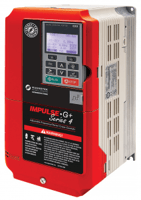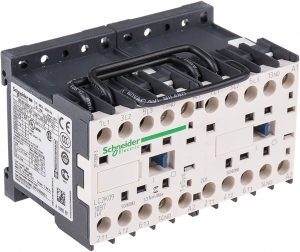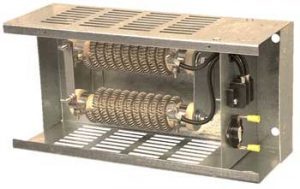-
PRODUCTSreturn
-
SERVICES AND PARTS
-
ABOUT US
Speed drive vs contactor: what to choose for my overhead crane?
8:23
Overhead cranes need to move at different speeds, depending on the application and production stage. This is why 2-speed equipment is so common. Over time, however, needs became more specific, and certain operations required greater flexibility. For this reason, a new technology was born: variable speed drives.
As this technology becomes more and more widespread, many people are wondering whether it should be included on all appliances. However, as with any product, the big question is whether it suits your needs. In this article, we’ll answer the following questions: What is a variable speed drive? What are the 3 types of speed systems available in the lifting industry? What are the pros and cons of each? This will help you determine whether this technology is the right one for your project, or another might provide a better service.
What is a variable speed drive?
A variable speed drive, also known as a Variable Frequency Drive (VFD), is an electronic system that modulates the speed of a motor as desired, and thus modifies acceleration and deceleration ramps. This technology also offers another interesting advantage: you can choose a speed that lies between the minimum and maximum speeds. In other words, it’s no longer a question of being limited between two speeds, for example 6.3 meters per minute (m/min) or 25m/min, but rather of choosing a speed between the two.

Variable speed drive (VFD)
Think of it as a dimmer switch. A switch set at the highest will give maximum light, while at the lowest it will generate minimum light. But it’s also possible to achieve the desired in-between. Although there are differences with the way VFDs work, the principle is the same. Now, what technologies are available for overhead cranes?
The 3 types of motor and speed
There are 2 main types of motor and speed: the 2-speed contactor system, and the standard variable speed drive. A 3rd type has also appeared, but before analyzing it, let’s see how the first 2 work.

Contactor inverter
The motor with contactor control has 2 windings. Each winding gives access to one speed, either high or low. It is precisely the contactors that will activate or not depending on the command made by the operator. In the case of the VFD, a specific motor (inverter duty) is combined with the inverter module itself, making it possible to adjust the frequency and thus obtain an acceleration and deceleration ramp. The ramp is programmable from the VFD control panel. It is also possible to select an intermediate speed between minimum and maximum speed from the operator control, a useful feature especially when travelling at high speeds.
Note, however, that both the 2-speed motor and the VFD motor generate an acceleration and deceleration ramp. In other words, even a 2-speed motor won’t move forward abruptly when you press the control but will gradually build up to the desired speed. The difference between the two is that the acceleration and deceleration of a 2-speed motor is achieved by a mass of inertia (or mechanical resistance), whereas the VFD uses programmed electrical frequencies.
The 3rd type, which we will call exclusive VFD 1 , is a variable frequency drive developed on the same principle as the standard drive, but with some limitations. Firstly, its first speed will be slower than the standard VFD. In addition, its ratio is reduced. This means that the range between its low speed and high speed is reduced. As a result, a standard VFD will allow a ratio of 10:1, while an exclusive VFD will be the same as a contactor system, i.e. 4:1. What does this mean in practice? If the maximum speed is 25 m/min, the standard VFD will be able to travel at 2.5 m/min in low gear, whereas the exclusive VFD will not go below 6.3 m/min. Secondly, the duty cycle 2 of its motor, in other words its recommended operating time, is reduced. One of the reasons for this is that the motor is not ventilated.
Comparison table of travelling speed systems
|
|
2 Speeds
 |
Variable |
Exclusive variable |
|---|---|---|---|
|
Control |
Contactor |
Standard variable frequency drive (VFD) |
Exclusive variable frequency drive (VFD) |
|
Price |
Lowest value $ |
Higher $$$ |
Intermediate $$ |
|
Ratio between high and low travel speeds |
4:1 |
10:1 |
4:1 |
|
Acceleration and deceleration |
Cylindrical rotor with inertia mass |
Programmable |
Programmable |
|
Speed range (based on a maximum speed of 25 m/min)
|
6,3 and 25 m/min
|
2,5 to 25 m/min
|
6,3 to 25 m/min
|
|
Button position 1 (0-1 = accel./decel. ramp)
|
0 to 6,3 m/min
|
0 to 2,5 m/min
|
0 to 6,3 m/min
|
|
Button position 2 (1-2)
|
Ramp from 6.3 to 25 m/min
|
Varies between 2.5 and 25m/min
|
Varies between 6.3 and 25m/min
|
|
Manufacturer of the variable frequency drive (VFD)
|
n/a |
Magnetek / Schneider / Vacon (Other manufacturers on request)
|
Varies according to year of manufacture
|
|
Motor duty cycle
|
40/20%
|
60%
|
40% |
|
Motor housing
|
T.E.F.C. Totally Enclosed Fan Cooled
|
T.E.F.C. Totally Enclosed Fan Cooled
|
T.E.N.V. Totally Enclosed Not Ventilated
|
|
Brake type
|
Self-adjusting disc brake
|
Self-adjusting disc brake
|
Self-adjusting disc brake |
Pros and cons
All these details are highly technical. But how does all this translate into pros and cons for the user?
The main advantages of a variable speed drive are as follows:
- Enabling very low speed travel for precise handling. This is only possible with the standard VFD, which makes low speeds extremely slow thanks to its 10:1 ratio.
- Save on brake wear for use on hoists with very high duty cycles. This is the case for cranes of class D and above (CMAA classification). This is made possible by programmable frequency braking rather than mechanical braking. However, this advantage applies mainly in the case of a standard VFD, as the exclusive VFD motor is less suited to this class of equipment.
- Enable movement at the speed required by the production cycle. For example, a VFD will allow parts to be transported at any speed between slow and fast. But when the equipment has no load, it may be more productive to move it at full speed to speed up the process. This option is useful where high travel speeds are required, e.g. 50 m/min and above.
The main advantages of a 2-speed contactor motor are:
- Basic technology with accessible, affordable parts
- Simple technology for easy maintenance
- Economical
In short, if your application requires delicate travel accuracy or you have Class D equipment, the standard VFD is recommended. But if you don’t need either of these, the contactor-based system will save you both on acquisition costs and on maintenance and productivity costs.
False beliefs
Here are a few false beliefs about variable frequency drives:
The VFD allows speed to be varied between 0 m/min and maximum speed. False. There is always a minimum speed for each VFD-specific motor. All the types mentioned in this article offer an acceleration ramp, but this ramp does not allow mid-stroke adjustments between speed 0 and minimum speed. The equipment will go from a stationary state to the minimum speed allowed by the motor without the operator being able to make any adjustments.
The VFD works exactly like a dimmer switch: the system sends out more or less voltage according to the pressure exerted on the control.
The variable speed drive on an overhead crane doesn’t work in the same way. It’s not just a question of voltage, but also of frequency. This system therefore needs the right motor (different from the 2-winding motor), a dynamic braking resistor as well as the variable speed drive module with specific programming. This makes it more complex and, in general, more expensive.

Braking resistor
Any VFD on the market does exactly the same job. False. As explained above, some combinations of VFDs with motors have limitations that could contravene the user’s particular application, and thus interfere with the objective pursued when acquiring lifting equipment.
Manager and partner at Premium Industrial Group
Learning Center
Whether you're an expert or know nothing about cranes, you'll find everything you need to know HERE.








